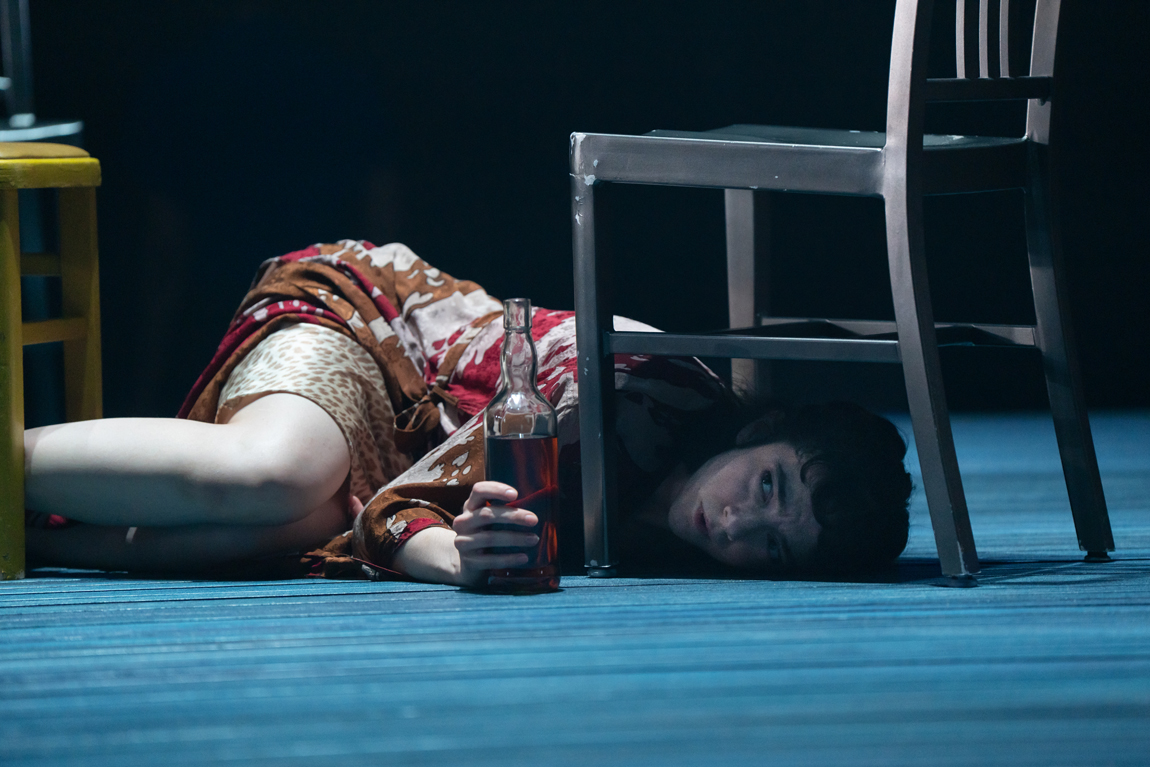 David Cote
David Cote
Danger comes knocking anew in Rebecca Frecknall’s searing revival of Tennessee Williams’s tragic play, starring Paul Mescal and Patsy Ferran.

Patsy Ferran as Blanche DuBois and Paul Mescal as Stanley Kowalski in A Streetcar Named Desire. Courtesy the Brooklyn Academy of Music. Photo: Julieta Cervantes.
A Streetcar Named Desire, written by Tennessee Williams, directed by Rebecca Frecknall, BAM Harvey Theater, 651 Fulton Street, Brooklyn, through April 6, 2025
• • •
Public discourse around sexual offenses aims for precision, not nuance. Pedophiles groom, abusers register, consent must be given, gender identities respected. That’s how it’s talked about, at least. But how to articulate the anarchy of desire within the vocabulary? A gaudy mask that term, desire: a paper lantern over a hot bulb. When Tennessee Williams tied the sighing word to a clattering hulk of electrified steel, he was telegraphing the all-too-human struggle of his third bow on Broadway, A Streetcar Named Desire (1947). Erotic appetite christening a mindless machine that could provide escape or run you over. His restless characters’ lower urges are sensationally messy, imprecise.

Patsy Ferran as Blanche DuBois in A Streetcar Named Desire. Courtesy the Brooklyn Academy of Music. Photo: Julieta Cervantes.
If the streetcar/desire dialectic doesn’t do it for you, try Blanche DuBois’s mantra. “I don’t want realism. I want magic!” she cries, declaring a preference for genteel euphemism, chivalric manners, and, yes, colored shades to soften the glare of a hundred watts. One of postwar American theater’s most beautiful dreamers (after all, her family estate is called Belle Reve), Blanche is a thirtyish, booze-guzzling Southern belle rung too many times by gentleman callers at a fleabag hotel in Laurel, Mississippi. Blanche needs all the delusions she can stuff in her travel trunk. Before she appears in Streetcar at the cramped New Orleans apartment of her sister, Stella, Blanche is well along a tragic tumble. Forced to sell the DuBois plantation, she was hounded from a teaching position for improper relations with a seventeen-year-old student. Blanche is still haunted by a doomed marriage years ago to a sensitive fellow who ultimately blew his brains out, prompted by her disgust upon discovering him with a male lover. So that’s the backstory of our hero: a dipsomaniacal sex worker and fabulist with a weakness for underage boys and blood on her hands.

Anjana Vasan as Stella Kowalski and Paul Mescal as Stanley Kowalski in A Streetcar Named Desire. Courtesy the Brooklyn Academy of Music. Photo: Julieta Cervantes.
But is Blanche the hero? She certainly can’t be the villain: that’s Stanley Kowalski, Stella’s uncouth, violent, all-ravening husband, who instantly pegs his visiting sister-in-law for a phony and a mooch. Stanley is prone to striking Stella during drunken rages (they make up later with coital zest), and his designs on Blanche—pecuniary and carnal—are grimly apparent from the start. Nobody deserves what Blanche gets at the greasy hands of Stanley, even if he’s as succulent a dish as Paul Mescal.

Paul Mescal as Stanley Kowalski in A Streetcar Named Desire. Courtesy the Brooklyn Academy of Music. Photo: Julieta Cervantes.
The Irish film and TV star (All of Us Strangers, Normal People) may be the name driving up ticket prices and attendance at BAM, but his performance is carefully integrated into Rebecca Frecknall’s keen, intelligently deconstructed revival. Mescal doesn’t shrink from his role’s indelible association with young Marlon Brando; the actor’s credibly flat accent (urban Midwest dusted with Brooklyn) and unforced physical beauty constitute what you might call a Brando-adjacent reading: not trying to reinvent the wheel but perfectly able to handle the curves.

Paul Mescal as Stanley Kowalski and Patsy Ferran as Blanche DuBois in A Streetcar Named Desire. Courtesy the Brooklyn Academy of Music. Photo: Julieta Cervantes.
Mescal’s Stanley has slightly melancholy Ted Bundy charm and a footballer’s stamina, sprinting laps around the Brutalist playing space (a raised platform on cinder blocks designed by Madeleine Girling), vaulting onto it, and flinging chairs about when particularly vexed. His muscular (mescular?) grace reaches its apogee in the infamous scene-ten showdown, as Stanley lasciviously targets a drunken Blanche, who breaks a bottle to defend herself. Mescal drops to the deck, purring, “Tiger, tiger!” Back arched, butt clenched in the air, he perches on fingers and toes and grins Cheshirely. It’s a grotesque yet arousing image, conveying both Stanley’s playfulness and his amoral attitude toward women, territory, and property. To widen the social horror, Frecknall adds beta hunters to Stanley’s pack. At the drum-accompanied climax of the scene, the male actors who play neighbors and street folk swarm Blanche and pounce.

Anjana Vasan as Stella Kowalski and Patsy Ferran as Blanche DuBois in A Streetcar Named Desire. Courtesy the Brooklyn Academy of Music. Photo: Julieta Cervantes.
If Mescal establishes a solid Stanley, Patsy Ferran wipes out conventional thinking about Blanche. The Spanish-British Ferran is thirty-five but reads twenty years younger, her wide eyes and mop top evoking a gamine teenager. When Ferran strips to slip and bra for Blanche’s frequent baths in the Nawlins heat, we see a thin and frail-looking frame. It’s a striking deviation from the usual celebrity casting of the role, which (in New York productions) has attracted mature, more voluptuous types, such as Cate Blanchett and Natasha Richardson, not to mention Vivien Leigh in Elia Kazan’s 1951 film. Ferran navigates Blanche’s baroque arias about “soft people,” of not “hanging back with the brutes,” with a fervent, piping voice that is less breathy diva and more manic-pixie kid sister. Here’s a Blanche stuck in dreamy girlhood on the plantation back in Laurel, shot by cupid at sweet sixteen. Ferran’s juvenilizing veneer makes Blanche’s violation by Stanley the more repugnant—but also complicates the scene in which she flirts with and kisses a teenage boy collecting for the local newspaper. If Blanche never really grew up, is it so wrong for her to pine for young flesh?

Patsy Ferran as Blanche DuBois in A Streetcar Named Desire. Courtesy the Brooklyn Academy of Music. Photo: Julieta Cervantes.
Seen two years ago at London’s Almeida Theatre and then on the West End, this nerve-scraping sandblast of a revival comes to Brooklyn trailing a fair amount of well-earned praise. As with her staging of Cabaret currently on Broadway, Frecknall dissects classic material with a handful of modish gestures: slow-motion tableaux, rain machines, stripped-back sets, ironized musical cues. But whereas her immersive, punk takedown of the Kander and Ebb coarsens the music and doesn’t add much to the Sontagian theme of fascinating fascism, Frecknall does a service for the Williams by making it dangerous again, a domestic trial that pits starvation against table manners. When actors aren’t involved in scenes, they sit watching on the edge of the playing space, placing prop cigarettes or whiskey bottles for use moments later. This exposed-brick approach creates a French Quarter panopticon, a sense of people living on top of each other in a humid, noisy zoo. The dialogue extraneous to the central battle between the principals (which includes subdued but affecting turns by Anjana Vasan as Stella and Dwane Walcott as Blanche’s hapless courtier, Mitch) is sped through, as if filtered through Blanche’s bewildered, appalled POV. If the physical environment is glumly industrial, Merle Hensel’s costume palette is surprisingly delicate, jewel-toned streetwear suggesting the late 1940s.

Cast of A Streetcar Named Desire. Courtesy the Brooklyn Academy of Music. Photo: Julieta Cervantes.
In place of the “Blue Piano” Williams suggests in stage directions for musical cues to set the mood, Frecknall goes for jungle jazz: seated high above the fray, actor-drummer Tom Penn whales away on his kit to punctuate the action. At other times, subliminally reminding us of the paper lantern hanging center stage, a Singer (Gabriela García) croons “Paper Doll” into a mic, or Jabez Sykes, playing the ghost of Blanche’s dead husband, cheerfully whistles “Paper Moon” as he strolls through her waking nightmares.

Anjana Vasan as Stella Kowalski and Paul Mescal as Stanley Kowalski in A Streetcar Named Desire. Courtesy the Brooklyn Academy of Music. Photo: Julieta Cervantes.
So much depends on that flimsy yet fraught paper lantern in Frecknall’s intense, claustral mise-en-scène. Of the many moments that linger, one of the most potent is a bit of stage business following the brawl between Stanley and Stella, after the boozy poker game broken up due to Stanley’s spasm of domestic abuse. Mescal has sobbed like a child and bellowed Stanley’s much-parodied “Stell-lahhhhh!” His wife comes; they embrace. Stanley lifts Stella high off the floor. Her head brushes the red paper lantern Blanche asked Mitch to hang, knocking it off the bulb to the floor. Stella doesn’t want magic. She wants realism: Stanley’s sweaty, predatory skin. In the end, there’s no moral way to reconcile Stella’s spousal loyalty with allowing her sister—fully dissociating after the sexual assault—to be dragged away to an asylum. That’s what tragedy is: a forced resolution where everyone loses. Mescal wraps a weeping Vasan in his apelike clutch, murmuring, “Now, love,” as the streetcar dances off the tracks.
David Cote is a theater critic, playwright, and librettist based in Manhattan. He reviews theater for Observer. His work has been produced in New York, London, and around the US.